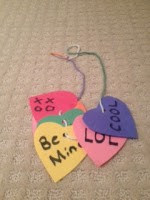Will You Be My Valentine?
(Tune: “Do You Know the Muffin Man?”)
Will you be my Valentine, (Point to various friends.)
Valentine, Valentine?
Will you be my Valentine?
I’ll be yours if you’ll be mine! (Point to self and then a friend.)
Some are red, some are blue, (Hold up fingers.)
Some have lace and ribbons, too.
Some are funny, some are not. (Smile and then shake head “no.”)
I like the candy ones a lot.
*Download this book at drjean.org.
Bringing Home a Valentine
(Tune: “Baby Bumblebee”)
I’m bringing home a valentine for you, (Cup hands and move them to
One that says, “I love you.” the beat in front of your body.)
I’m bringing home a valentine for you
With a great big hug, and a (kiss) (kiss), too! (Hug self and then kiss
in the air.)
Softer….hum

The Broken Heart
Here’s a story just right for this month to help children think about how words can hurt. Cut a large heart out of red construction paper and hold it in your lap as you begin to tell the story below:
This is a story about a special friend named (imaginary name). He always came to school with a smile on his face and a big heart full of love for his classmates. (Hold up the big heart.) (Name) listened to his teacher, did his best work, and helped his friends. However, some of his friends weren’t always so kind. Joe made fun of his shoes and broke a little of his heart. (Tear off a piece of the heart and let it drop to the floor.) Ann said, “I’m saving this seat and you can’t sit here” at story time and broke a little more of his heart. Sammy wouldn’t share his crayons (tear off a little of the heart) and Sara called him a mean name. What are some other things that might break his heart? (Let the children name other things that cause hurt feelings as you let the pieces fall to the floor.) By the end of the day his heart was all in pieces and it was so sad.
Who can tell me how to put his heart back together? What are some kind things you can do for your friends? As children name different acts of kindness pick the pieces of the heart off the floor. Glue the pieces together on a poster as a reminder to have a kind heart. Encourage children to write friends’ names on the poster when they are kind and helpful to them!

Run off "Kindness Tickets" and distribute them to your students. Children can thank friends for a kindness shown by writing their name on a ticket.
https://drive.google.com/file/d/0B1SnEagA4jljaHRsT05ZYmxPZlE/view?usp=sharing


















































